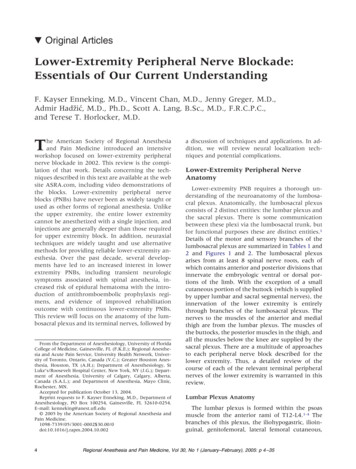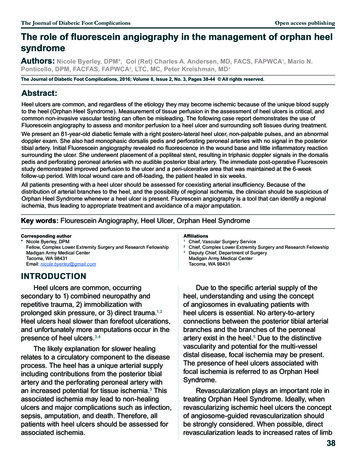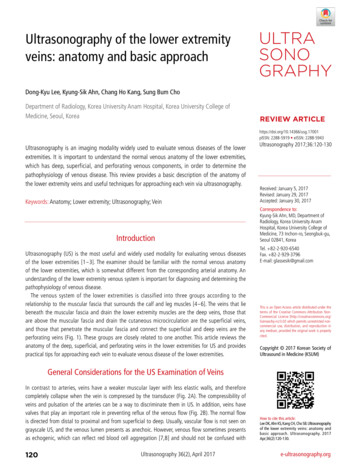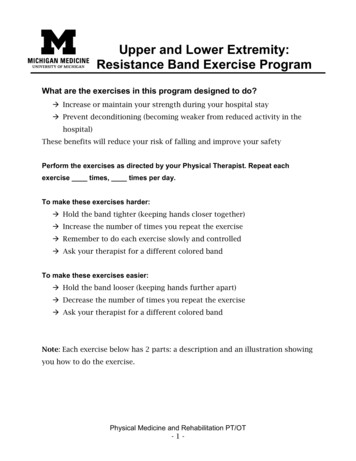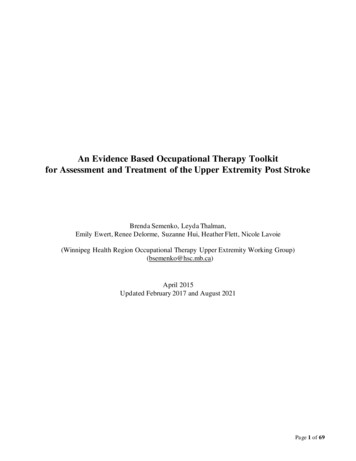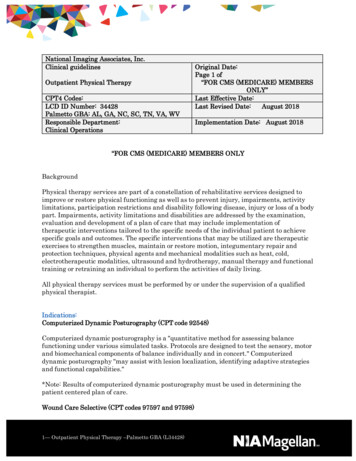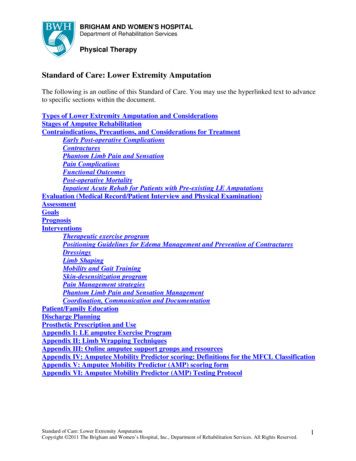
Transcription
BRIGHAM AND WOMEN’S HOSPITALDepartment of Rehabilitation ServicesPhysical TherapyStandard of Care: Lower Extremity AmputationThe following is an outline of this Standard of Care. You may use the hyperlinked text to advanceto specific sections within the document.Types of Lower Extremity Amputation and ConsiderationsStages of Amputee RehabilitationContraindications, Precautions, and Considerations for TreatmentEarly Post-operative ComplicationsContracturesPhantom Limb Pain and SensationPain ComplicationsFunctional OutcomesPost-operative MortalityInpatient Acute Rehab for Patients with Pre-existing LE AmputationsEvaluation (Medical Record/Patient Interview and Physical herapeutic exercise programPositioning Guidelines for Edema Management and Prevention of ContracturesDressingsLimb ShapingMobility and Gait TrainingSkin-desensitization programPain Management strategiesPhantom Limb Pain and Sensation ManagementCoordination, Communication and DocumentationPatient/Family EducationDischarge PlanningProsthetic Prescription and UseAppendix I: LE amputee Exercise ProgramAppendix II: Limb Wrapping TechniquesAppendix III: Online amputee support groups and resourcesAppendix IV: Amputee Mobility Predictor scoring: Definitions for the MFCL ClassificationAppendix V: Amputee Mobility Predictor (AMP) scoring formAppendix VI: Amputee Mobility Predictor (AMP) Testing ProtocolStandard of Care: Lower Extremity AmputationCopyright 2011 The Brigham and Women’s Hospital, Inc., Department of Rehabilitation Services. All Rights Reserved.1
Case Type / Diagnosis:Practice Pattern:4J: Impaired Gait, Locomotion, and Balance and Impaired Motor Function Secondary to LowerExtremity Amputation. Other Practice Patterns may be applicable as well.ICD 9 Codes:84.1, 84.3, 84.13, 84.14, 84.15, 84.16, 84.17This standard of care applies to any patient after a lower extremity (LE) amputation, includingtransfemoral (above-knee amputation or AKA), transtibial (below-knee amputation or BKA),transmetatarsal amputation (TMA), and toe amputations. This standard of care is intended to serveas a guide for clinical decision-making for physical therapy management of this patient populationfor Brigham and Women’s Hospital (BWH) physical therapy services.Limb amputation results in significant changes in body structures and functions. There is thephysical loss of a body part as well as the closely related effects of the underlying disease,comorbidities, and concurrent injuries1. Prosthetic fitting may compensate for the loss of bodystructures and function of the affected limb(s). Persons with amputations may also experience awide range of activity limitations and participation restrictions. Typical activity limitations andparticipation restrictions for lower extremity amputees relate to self-care activities and mobility.These affect the ability of the person to return to and maintain work, maintain social relationships,participate in leisure activities and be active members of the community1. Environmental factorssuch as barriers in the community related to physical/structural environments, as well as personalfactors such as age, sex, level of education and ability to adjust, may restrict participation innormal social roles for persons with lower extremity amputation1.An important basis for optimal acute and long-term physical therapy management of amputees isan in-depth understanding of the patient and the functional consequences of the amputation,systemic and detailed consideration of the patient and their environment, and sound measurementof functional outcomes1.Prevalence of amputations internationally has been reported as 17-30 per 100,000 persons1. Nonindustrialized countries generally have a higher incidence due to a higher rate of war, trauma, andless developed medical systems1. Trauma is the most common cause of amputations in nonindustrialized countries1. The continued high levels of conflict worldwide, including continued useof land mines and increased use of motorized transportation, will result in an increasing prevalenceof persons with an amputation globally, equating to an increase in the number of persons withchronic disabling conditions1.In the U.S., limb amputations due to dysvacular causes such as peripheral vascular disease (PVD),Diabetes Mellitus (DM) or Chronic Venous Insufficiency (CVI) account for 82% of all lowerextremity (LE) amputations2. Other causes of LE amputations are trauma (16.4%), cancer andmalignancies (0.9%), and congenital deficiencies (0.8%)2. From 1988-1996 the rates ofdysvascular amputations in the United States increased 26.9%, while rates of cancer and traumarelated amputations decreased 42.6% and 50.2%, respectively2. Risk of amputation increases withStandard of Care: Lower Extremity AmputationCopyright 2011 The Brigham and Women’s Hospital, Inc., Department of Rehabilitation Services. All Rights Reserved.2
age, regardless of etiology, sex, and race; though the rate of increase is especially high amongblacks requiring dysvascular amputations2. Males are at a significantly higher risk for traumarelated amputations than females2. The leading causes of trauma-related amputations have beenreported to be injuries involving machinery (40.1%), powered tools and appliances (27.8%),firearms (8.5%), and motor vehicle crashes (8%)3.The language used in this standard is consistent with the World Health Organization (WHO)International Classification of Function, Disability, and Health (ICF). The InternationalClassification of Functioning, Disability and Health, also known as ICF, is a classification ofhealth and health-related domains. These domains are classified from body, individual and societalperspectives by means of two lists: a list of body functions and structure, and a list of domains ofactivity and participation. Since an individual’s functioning and disability occurs in a context, theICF also includes a list of environmental and personal factors. For more information on this type ofdocumentation please refer to your mentor or reference material available in the department or online at the World Health Organization’s web ications for Treatment:This standard of care applies to any new lower extremity amputation due to vascular disease,diabetes mellitus, trauma, infections, presence of tumor, or other limb deficiencies. It also appliesto any new admission for persons who have had a previous lower extremity amputation and are atrisk for edema, weakness and/or contractures due to medical issues necessitating admission toBWH.Types of Lower Extremity Amputation and Considerations4, organized by anatomical location,distal to proximal:1. Toe Amputation: Phalangeal or partial toe amputation involves excision of any part of one or more of thetoes. Common, account for 24% of DM amputations. Prosthesis is not usually necessary. Patients’ may have weight-bearing restrictions, the Physical Therapist needs to clarifywith surgical team. In dysvascular cases where neither pain nor infection is a concern, auto-amputation canbe awaited5.2. Transphalangeal Amputation (Toe Disarticulation): Amputation done at the metatarsophalangeal joint. May result in biomechanical deficiencies:o Amputation of great toe affects push-off during fast gait and running, and may resultin a non-propulsive gait pattern.o If the base of the proximal phalanx with the insertion of the flexor hallucis brevis issaved, stability is enhanced.o Second-digit amputation results in severe hallux valgus.3. Transmetatarsal Amputation (TMA):Standard of Care: Lower Extremity AmputationCopyright 2011 The Brigham and Women’s Hospital, Inc., Department of Rehabilitation Services. All Rights Reserved.3
4.5.6.7.Foot amputation in which a dorsal incision is made through the mid- to proximalmetatarsal shafts, and a long, thick myocutaneous plantar flap including the flexortendons is used, with closure of this flap onto the dorsum of the foot. There are approximately 10,000 TMA’s performed each year in the U.S. Patients’ may have weight-bearing restrictions. The Physical Therapist needs to clarifythese restrictions with the surgical team. Once incision is healed and the patient is ambulatory, they may require a prostheticorthosis (rocker-bottom sole and a polypropylene ankle-foot orthosis (AFO)) to offsetincreased weight-bearing load on remaining tissues.Lisfranc Amputation: Performed at the tarsometatarsal joint and involves disarticulation of all five metatarsalsand digits. Uncommon Often result in an equinus and varus deformity due to the pull of the plantarflexors andloss of dorsiflexor and peroneal muscles.Chopart Amputation: At the talonavicular and calcaneocuboid joints, it involves disarticulation through themidtarsal joint leaving only the calcaneus and talus. Uncommon Often result in an equinus and varus deformity due to the pull of the plantarflexors andloss of dorsiflexor and peroneal muscles.o For Lisfrac, Chopart and transphalangeal amputations, orthotic shoe fillers or shoemodifications may be used, such as a spring-steel shank extending to the metatarsalheads, and a rocker sole or padding to the tongue of the shoe to assist in holding thehindfoot firmly in the shoe.Syme Amputation: Ankle disarticulation in which the heel pad is kept for good weight-bearing. Thick heel pad can allow direct weight-bearing. Post-operative complications may include an unstable heel flap, development of neuromaof the posterior tibial nerve, and poor cosmesis. Patients are typically kept non-weight-bearing (NWB) immediately post-op. UncommonTranstibial Amputation (BKA): Very short transtibial amputation occurs when less than 20% of tibial length is preserved.o May result from trauma, and not usually an elective procedure.o Results in small-moment arm, making knee extension difficult. Standard Transtibial Amputation occurs when between 20% and 50% of tibial length ispreserved.o At least 8cm of tibia is required below the knee joint for optimal fitting of aprosthesis. Long Transtibial Amputation occurs when more than 50% of tibial length is preserved.o Usually not advised due to poor blood supply to the distal leg. Long posterior flap is normally used because of good vascularization and it provides anexcellent weight-bearing surface. Fibula is usually transected 1-2cm shorter than the tibia to avoid distal fibula pain.Standard of Care: Lower Extremity AmputationCopyright 2011 The Brigham and Women’s Hospital, Inc., Department of Rehabilitation Services. All Rights Reserved.4
Transtibial amputations have been reported to account for 27.6% of dysvascularamputations performed in the U.S.2.8. Knee Disarticulation (Through-Knee Amputation or TKA): Old and anatomic procedure which does not require surgically cutting through bone ormuscular bellies. Offers good weight distribution and retains a long, powerful femoral lever arm. Yields a non-cosmetic socket due to need for an external joint mechanism and resultantdifficult swing-phase control. Often performed on patients who will not become a prosthetic walker, or in growingchildren to maintain femoral length.9. Supracondylar Amputation: Surgical procedure in which the patella is left for better end weight-bearing. Area between the end of the femur and patella may delay healing.10. Transfemoral Amputation (AKA): Short transfemoral amputations occur when less than 35% of the femoral length ispresent.o Uncommon Medium transfemoral amputations occur when between 35% and 60% of femoral lengthis preserved.o In general, the residual limb must be at least 4 to 6 inches in length from the groin tofit a prosthesis6.o Ideally, amputations should be at least 4 inches (10cm) above the lower end of thefemur to allow room for the prosthetic knee.o Normally, anterior and posterior muscular surfaces are well vascularized, so equalflaps are used. Long transfemoral amputations occur when more than 60% of femoral length is present. Transfemoral amputations have been reported to account for 25.8% of dysvascularamputations performed in the U.S.2.11. Hip Disarticulation: Involves loss of all the femur Uncommon Usually done in cases of malignant tumors, extensive gangrene, massive trauma, oradvanced infection.12. Hemipelvectomy: Involves loss of any part of the ilium, ischium, and pubis. Uncommon Can be internal, in which the limb is salvaged, or external, in which the limb is removed.External hemipelvectomy may also be referred to as a transpelvic amputation. Usually done in cases of malignant tumors, extensive gangrene, massive trauma, oradvanced infection.Standard of Care: Lower Extremity AmputationCopyright 2011 The Brigham and Women’s Hospital, Inc., Department of Rehabilitation Services. All Rights Reserved.5
Stages of Amputee Rehabilitation7:Rehabilitation after major lower extremity amputation can be divided up into nine specific periodsof evaluation and intervention, each with its’ particular set of treatment goals and objectives7.Communication among the interdisciplinary healthcare team, the patient, and with the patient’sfamily is essential. Each stage entails specific treatment objectives listed below, but care should befocused on individual treatment goals based on the patient’s health status, level of amputation, andrelevant personal and environmental factors.I. Preoperative – Involves medical and physical assessment, patient education, functionalprognosis, discussion about phantom limb pain, realistic short and long term goals. Optimal rehabilitation care of the amputee begins, if feasible, prior to the amputation8. If possible, patient should be placed in a cardiopulmonary conditioning program. 7.II. Amputation Surgery/Dressing – Involves surgical residual limb length determination, closure ofwound and soft-tissue coverage, nerve management, dressing application, and limbreconstruction. The residual limb must be surgically constructed to optimize the intimacy of fit of futureprosthesis, maintain muscle balance, and allow it to assume the stresses necessary to meetits new function8. An underlying goal of surgical management of patients’ requiring LE amputation is toretain the knee joint given its contribution to more efficient ambulation with a prosthesis,requiring less energy expenditure9.III. Acute Post-Surgical – This phase begins immediately post-operatively and continues until thepatient is discharged from the acute care hospital. Goals at this stage are pain control,optimization of range of motion (ROM) and strength of both lower and upper extremitymusculature, promotion of wound healing, phantom limb pain/sensation management, functionalmobility training, equipment prescription, and continued patient education and emotionalsupport7. See Treatment section below for specific guidelines.IV. Pre-prosthetic – Involves residual limb shaping, stump shrinking, skin care, increasing ROM andmuscle strength, cardiovascular training, progressive functional mobility training without aprosthesis, restoring locus of control of the patient, and patient education and preparation forprosthetic use4. During initial recovery it is important to restore the individuals’ locus of control. Generally 6-8 weeks or longer post-operatively with soft dressings, or 3-6 weeks with useof an Immediate Post-Operative Prosthesis (IPOP)4. Preparatory or training prosthesis may be used to promote residual limb maturation andfor use during gait training. Individuals are vulnerable to losses in strength and range of motion (contractures) duringthis period.V. Prosthetic Prescription/Fabrication – Involves team consensus on prosthetic prescription tosatisfy the needs, desires and abilities of the patient. Criteria for fitting of LE prosthesis: Wound must have healed, edema must have resolved,the stump should be conically shaped and stump maturation should be achieved10.o Obesity can be a limiting factor because most prosthetic devices are designed with amaximum load of 330 lbs11. Patients’ with advanced vascular pathology may be less likely to be able to use aprosthetic device due to poor skin integrity, delayed healing, and impaired aerobicStandard of Care: Lower Extremity AmputationCopyright 2011 The Brigham and Women’s Hospital, Inc., Department of Rehabilitation Services. All Rights Reserved.6
VI.VII.VIII.IX.capacity/endurance. If they are fit for a prosthesis, appropriate wound healing may takean extended period of time.Prosthetic Training – Prosthetic management and training to increase wearing time andfunctional use. For patients s/p AKA and BKA using a soft dressing after amputation, a cast for atemporary socket is often fabricated 6-8 weeks postoperatively4. Ambulation activities with a LE prosthesis often begin during weeks 10-11 afteramputation4. The more proximal the amputation, the more energy is demanded from the cardiovascularand pulmonary systems for prosthetic gait12.Community Integration – Involves resumption of family and community roles, addressingemotional needs and developing healthy coping strategies, and resumption of previous andadapted recreational activities.Vocational Rehabilitation – Involves assessment and training for work activities, and assessmentof further education needs or job modification On the basis of residual functional capacity, patients may be able to return to theirprevious line of work. In many cases patients’ may choose a different line of work,dependent on the physical demands of the job. For the successful reintegration of the amputee, return to work should take placegradually, with time and workload increasing over several weeks and clinical staffbeing available for counseling and consultation7.Follow-Up – Includes lifelong prosthetic, functional, and medical assessment and psychologicalsupport. Patients should be seen for follow-up by one of the team members at least every 3months for the first 18 months, with physical follow-up every 6 months7.Rehabilitation Management:Post-operatively, physical therapy (PT) plays an integral role in restoring function, preparingpatients for a lower-extremity orthotic or prosthetic device, and training them with that device onceit has been fabricated. At BWH, physical therapy is consulted post-operatively by the surgicalteam, and the acute post-surgical stage of amputee rehabilitation is initiated. The focus of physicaltherapy management begins with initial evaluation on POD#1 if the patient is medically/surgicallyappropriate, and includes patient education, mobility, functional training, as well as promotingwound healing, and optimizing ROM and motor control of the residual and non-affected limbs.Early mobility has been shown to improve functional outcomes, foster independence, decreasemortality rates, and reduce acute care length of stay for the person s/p LE amputation13. Amongelderly amputees, an early coordinated post-amputation rehabilitation program may reduce thetime to prosthetic ambulation and the risk of further disability12. If immobility and associateddeconditioning and contracture formation in the residual limb are allowed to occur, prostheticfitting and functional outcomes are compromised3. Knowledge of the basic concepts in LEamputee rehabilitation and the acute care hospital course will help to guide clinical decisionmaking in the outpatient physical therapy setting.Standard of Care: Lower Extremity AmputationCopyright 2011 The Brigham and Women’s Hospital, Inc., Department of Rehabilitation Services. All Rights Reserved.7
Contraindications, Precautions, and Considerations for Treatment:Below are common issues specific to patients undergoing any LE amputation that may impactphysical therapy intervention and overall prognosis.Early Post-operative Complications:Recognition of signs and symptoms of early post-operative complications is important and willrequire consultation with appropriate health care providers. Potential complications that occurduring the acute care hospital stay that would increase morbidity/mortality and impact the patient’sability to participate in therapy, and influence overall prognosis and treatment design and goalsare: Blood loss requiring transfusion Deep vein thrombosis (DVT) Pulmonary embolism (PE) Cardiac complications including arrhythmia, congestive heart failure (CHF), andmyocardial infarction (MI)9. Systemic complications including pneumonia, renal failure, stroke, and sepsis9. Complications at the surgical site include hemorrhage or hematoma, wound infection, andfailure to heal requiring additional operative interventions such as split-thickness skingrafting (STSG), hematoma evacuation, soft tissue debridement, stump revision, andconversion to AKA after BKA9.If a patient presents during the first few days post-operatively with increased pain, excessiveswelling, decreased muscle strength or sensation along a motor and/or sensory nerve distribution,sudden shortness of breath and decreased oxygen saturation along with increased resting heart rate,physical therapy interventions must be stopped, and the medical team consulted.Also see “General Surgery” Standard of Care for general post-operative precautions andcontraindications that may affect appropriateness of PT intervention.Contractures:Joint contractures are serious complications that may interfere with prosthetic fitting and propergait, and will eventually increase the energy requirements of ambulation14. The joints immediatelyproximal to the amputation site may develop contractures if full range of motion is not initiated inthe early post-operative period. Joint contractures can be avoided with proper positioning andexercise. See “Positioning Guidelines for Edema Management and Prevention of Contractures” inthe intervention section below.Phantom Limb Pain and Sensation:Phantom limb sensation is the sensation that the limb is still present, and phantom pain includesthe various painful sensations in the body part that is no longer present15. Immediate post-operative incidence of phantom pain and phantom sensation has beenreported to be 72% and 84%, respectively, while the incidence at 6 months post-operativelychanges to 67% and 90%, respectively15. Both phantom pain and sensation are generally localized to the distal part of the missinglimb15. Persons with phantom limb pain have worse or lower health-related Quality of Life (QOL)than persons without phantom pain16.Standard of Care: Lower Extremity AmputationCopyright 2011 The Brigham and Women’s Hospital, Inc., Department of Rehabilitation Services. All Rights Reserved.8
Pre-amputation pain has been shown to significantly increase the incidence of phantompain post-amputation17.Phantom limb pain and prosthetic use may be inversely related, as it has been shown thatpersons using their prosthetic limbs 9 or more hours per day have less phantom pain thanothers15.Treatments for phantom-limb related symptoms include:o Pharmacological interventions such as opiods, anticonvulsants, antidepressants,botulinum toxin, and topical agents such as lidocaine18.o Surgical treatments such as stump revision, intrathecal implants, trigger pointinjections, dorsal root entry zone lesions, and dorsal column tractotomy have beendescribed. Due to risk of complications and limited benefit, these are generally used ina limited number of patients15.o Physical Therapy modalities and techniques as described in the Treatments sectionbelow.o Alternative techniques such as acupuncture and hypnosis may also be beneficial. 18.Pain Complications:Other causes of pain in individuals undergoing LE amputation may include neuromas, reflexsympathetic dystrophy and bursitis or tendonitis at the end of the residual limb14. Neuroma formation is a natural repair phenomenon that may occur when a peripheral nerveis transected. During the repair phase, axons turn back on themselves and combine withfibrous tissue to form an enlargement at the distal nerve end. Pain occurs when theneuroma is situated at the end of the residual limb or at a pressure point in the prosthesis.Nonoperative interventions include injections with local analgesics or corticosteroids. Ifthese interventions are ineffective, surgical excision of the neuroma is the treatment ofchoice14. Reflex sympathetic dystrophy, also called complex regional pain syndrome, includessensory, autonomic and motor symptoms that may occur in the affected extremity. Thehallmark of this condition is severe, unremitting pain that is out of proportion to the injury.Pain is thought to be caused by an abnormal prolongation of the sympathetic reaction to theinjury which produces vasospasm, hyperhidrosis and erythema. Early treatment mayinclude interruption of the abnormal sympathetic reflex with the use of TENS orsympathetic blocks, pharmacologic agents, and physical therapy14. Bursitis or tendonitis may cause aggravating residual limb pain, characterized by localizedtenderness, mild edema, slight occasional erythema of the overlying skin, increased skintemperature, and subcutaneous crepitus. If tendonitis is present, passive stretching of theinvolved tendon will cause significant pain. Intervention may include cessation ofprovocative activities, oral non-steroidal anti-inflammatory medications, temporarydiscontinuation of the prosthesis, rigid immobilization for brief periods, compressiondressings, thermal modalities, corticosteroid injections, analgesic medications, and/ormodification of the prosthetic socket14.Functional Outcomes:While up to 85% of vascular amputees are fitted with a prosthesis after major LE amputation, only5% of these persons use their prosthesis for more than half of their waking hours17. Within 5 yearsthe use of the prosthesis drops from 85% to 31%. Two years after major LE amputation only 26%Standard of Care: Lower Extremity AmputationCopyright 2011 The Brigham and Women’s Hospital, Inc., Department of Rehabilitation Services. All Rights Reserved.9
are walking outdoors17. The proportion of total wheelchair users rises from 13% in the first yearafter surgery to 39% after 5 years17. For persons undergoing Syme amputation (ankledisarticulation), the cumulative ambulatory rate at 1, 2, and 5 years has been reported to be 92%,80% and 80%, respectively17.Post-operative Mortality:The life expectation of vascular amputees is short. Survival rates for individuals with dysvascularpathology undergoing major LE amputations including AKA and BKA have been reported as69.7% and 34.7% at 1 and 5 years, respectively. Mortality was found to be significantly higher forpatients who underwent AKA (50.6% and 22.5% at 1 and 5 years) as compared to BKA (74.5%and 37.8% at 1 and 5 years)9.Inpatient Acute Rehab for Patients with Pre-existing LE Amputations:Patients’ with pre-existing LE amputations may be admitted to the inpatient acute care setting for avariety of medical reasons related to their amputation or due to unrelated medical issues, includingcardiopulmonary and vascular disease. Physical therapy evaluation and intervention for theseindividuals may begin as soon as the patient is medically stable. Considerations, examinationprinciples and interventions described in this standard of care are applicable in the physical therapymanagement of these patients. During the patient interview special attention should be focused onassessing the patients’ prior level of function, use of assistive devices and prosthetic use. Prostheticdevices should be brought in from home for these patients to assist with mobility retraining.Edema of the residual limb and/or muscular atrophy related to medical issues or immobility ispossible, which will affect the patients’ ability to don a prosthesis. Therefore, interventiontechniques for edema management described below, including limb wrapping, may be beneficialand should be implemented.EvaluationThis section is intended to capture the most commonly used assessment tools for this casetype/diagnosis. It is not intended to be either inclusive or exclusive of assessment tools.Medical Record Review/Patient Interview:A. HPI & PMH: Onset and duration of symptoms and reason for admission Anthropometrics: (height, weight, BMI) Tobacco use Presence of co-morbid conditions that may affect outcomes, including peripheralvascular disease, diabetes mellitus, coronary artery disease, previous myocardialinfarction, valvular disease, congestive heart failure, severe pulmonary disease (COPDor asthma), vision and/or cognitive impairment, and obesity.B. Hospital Course: Previous and ongoing medical and/or surgical treatment, date of any procedures andany post-operative complications. Current laboratory results: WBC, HCT, HGB, PLT, INR, PTT, Blood glucose levels.C. Pertinent Current Medications: (e.g. cardiac, pulmonary, pain) Types of medications, side effects and rehabilitation implications.D. Social History:Standard of Care: Lower Extremity AmputationCopyright 2011 The Brigham and Women’s Hospital, Inc., Department of Rehabilitation Services. All Rights Reserved.10
Prior functional level, use of assistive devicesHome environment and current/potential barriers to returning homeFamily/caregiver support system availableFamily, professional, social and community rolesPatient’s goals and expectations of returning to previous life rolesPhysical Examination (Systems Review):A. Subjective: Documentation can include patients’ goals, or comments about their current medicalstatus or psychological well-being.B. Observation: Lines and tubes. Positioning: Position of residual limb and fit of knee immobilizer (if BKA)C. Cognition/Mental Status: Level of alertness, ability to follow motor commands, and level of safety awareness. Consider screening with Mini Mental State Examination, or ask for an occupationaltherapy consult. Personality changes: e.g., emotional lability, euphoria Fear and Anxiety Mental status: Level of alertness, orie
The language used in this standard is consistent with the World Health Organization (WHO) International Classification of Function, Disability, and Health (ICF). The International Classification of Functioning, Disability and Health, also known as ICF, is a classification of health and health-related domains.
